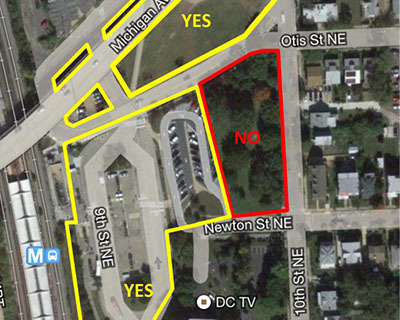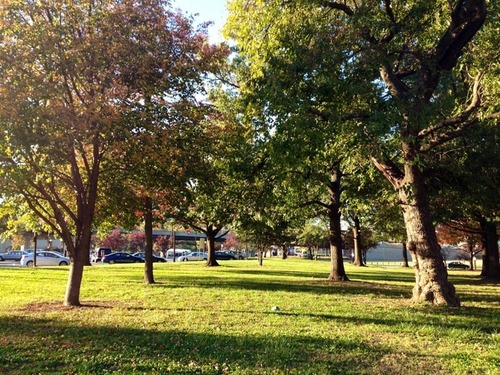
As new investment rejuvenates Brookland, WMATA is seeking a developer to build at the Brookland Metro station. But neighbors and local nonprofit Casey Trees want to ensure that future development leaves room for green space as well.

The proposed development with amendments as envisioned by neighbors, including a preserved Brookland Green (in red). All images from Brookland Bridge.
The Washington Metropolitan Area Transit Authority (WMATA) plans to seek a developer to build a mixed-use joint development on the property surrounding the Metro station, including the bus bays, a kiss-and-ride lot and a vacant lot along Michigan Avenue NE. Also slated for development is what residents call the Brookland Green, an approximately .75 acre green space adjacent to the Metro station entrance that boasts 20 mature trees.
Neighbors are asking WMATA to amend their joint development solicitation to preserve the Brookland Green. They have the support of Ward 5 Councilmember Kenyan McDuffie and Casey Trees, a nonprofit organization based in Brookland best known for planting trees. They feel that it is not only possible, but also more desirable to redevelop the Brookland Metro station while preserving this park space as a core asset for the growing number of DC residents that call Brookland home.
Building around Metro stations like Brookland, typically referred to as a Transit Oriented Development (TOD) is more sustainable than traditional development because it puts people near public transportation, reducing their dependence on automobiles. While the presence of transit and density are two components of TOD, truly sustainable communities also provide access to green space and trees.
Preserving the Brookland Green fits with Mayor Gray’s Vision for a Sustainable DC, which recognizes the benefits of trees. The plan sets goals to provide parks or natural space within a ten-minute walk of all residents, as well as to increase tree canopy coverage to 40% across the District.
Research indicates that the green spaces we experience everyday have a greater influence on our health and wellbeing than those that we visit occasionally. Our major national parks, such as the National Arboretum, the National Mall and Rock Creek Park, are wonderful places to visit. But the Brookland Green’s proximity to the Metro provides a greater number of people with the daily access to nature and can improve the surrounding urban environment, by decreasing stormwater runoff, filtering our air and cooling the city.
Furthermore, the presence of trees near business districts can enhance sales: several studies have shown that people are willing to visit more frequently and travel farther to business districts with trees, and they are also willing to pay an average of 12% more for goods and services in these areas.
The Brookland Metro station is fortunate to have an existing amenity that provides both of these elements of green space and a lush tree canopy to its residents. So why should we not preserve that within the new development?
